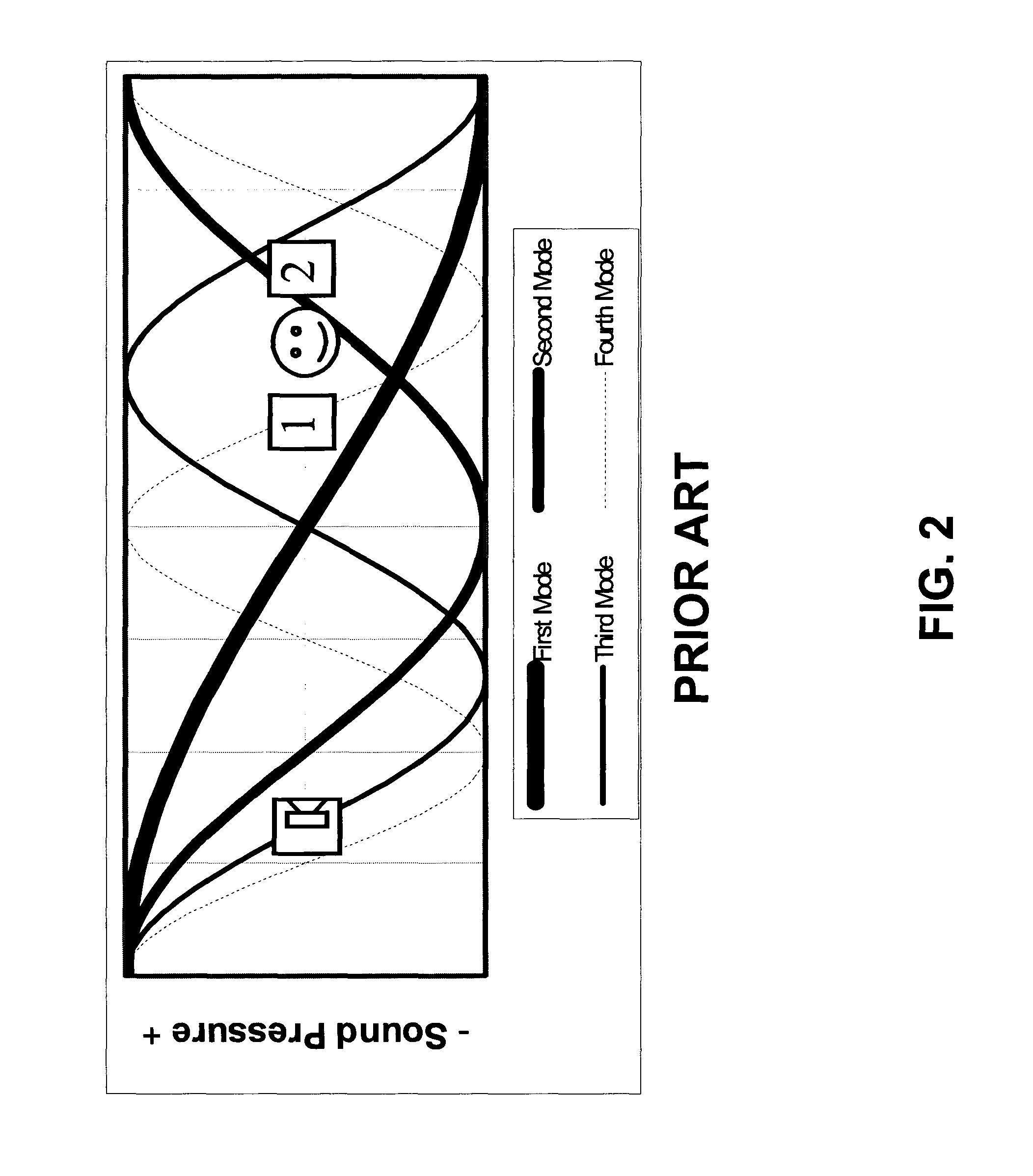System for selecting speaker locations in an audio system
a speaker location and audio system technology, applied in the direction of stereophonic arrangments, stereophonic circuit arrangements, pseudo-stereo systems, etc., can solve the problems of incorrect amplitude deviation, single location potentially creating problems, and adversely affecting the frequency response performance of the sound system
- Summary
- Abstract
- Description
- Claims
- Application Information
AI Technical Summary
Problems solved by technology
Method used
Image
Examples
example 1
[0197]The first system investigated is not a dedicated home theater. Therefore, the existing subwoofer locations are a compromise between low frequency performance and aesthetic concerns. FIG. 15 is the layout for the room in Example 1, the scale of which is approximately 100:1. The square boxes represent the two subwoofer locations and the circles represent the three listening positions. The room depicted in FIG. 15 is approximately 27′×13′, with a 45° angle for one of the walls, and has a 9′ ceiling. The walls and ceiling are constructed of drywall and 2″×6″ studs. The floor is constructed of a concrete slab and is covered with ceramic tile. An area rug covers a large portion of the floor.
[0198]FIG. 16 describes the low frequency performance of the system before low-frequency analysis was applied. The heavy solid curve in the middle of FIG. 16 is the average amplitude response for the three listening positions. The lighter middle curves are the responses at each listening position...
example 2
[0201]The second system investigated in Example 2 is a $300,000+ dedicated home theater. FIG. 18 describes the layout of the room in Example 2. The system features one subwoofer in each corner of the room, a front-projection video system and a riser for the second row of seating. The room is approximately 26′×17′ and has a 9′ ceiling. Two of the walls are constructed of concrete blocks and two of the walls are constructed from drywall and 2″×4″ studs. The floor is a carpeted concrete slab. The second row of seating is on an 8″ riser constructed of plywood and 2″×4″ studs. The room features extensive damping on all walls. FIGS. 19 and 20 define the low frequency performance before and after low-frequency analysis. Table 2 compares the performance of the system in Example 2 before and after low-frequency analysis.
[0202]
TABLE 2Low-frequencyMeanVariance ofActiveanalysisSpatialthe spatialAcousticSubwoofers(yes / no)VarianceaverageEfficiency1, 2, 3, 4No5.1 dB21.3 dB−17.3 dB1, 2, 3, 4Yes2.1 ...
example 3
[0204]The third system in Example 3 comprises a home theater set-up in a family room. FIG. 21 shows the layout of the room in Example 3. The room is approximately 22′×21′ and features a sloped ceiling. The walls and ceiling are constructed of drywall and 2″×4″ studs. The floor is a concrete slab with the perimeter covered by tile and the central area carpeted. The left side wall features several windows which can be (and were) covered by heavy drapes. The system originally featured two subwoofers in the front of the room. FIG. 22 describes the low frequency performance in the original configuration before low-frequency analysis was applied, with the system constrained to using subwoofers 1 and 2 in the front of the room. FIG. 23 describes the low frequency performance after low-frequency analysis was applied, with the system constrained to using subwoofers 1 and 2. Two additional subwoofers were placed in the back of the room and low-frequency analysis was applied, the results of wh...
PUM
 Login to View More
Login to View More Abstract
Description
Claims
Application Information
 Login to View More
Login to View More - R&D
- Intellectual Property
- Life Sciences
- Materials
- Tech Scout
- Unparalleled Data Quality
- Higher Quality Content
- 60% Fewer Hallucinations
Browse by: Latest US Patents, China's latest patents, Technical Efficacy Thesaurus, Application Domain, Technology Topic, Popular Technical Reports.
© 2025 PatSnap. All rights reserved.Legal|Privacy policy|Modern Slavery Act Transparency Statement|Sitemap|About US| Contact US: help@patsnap.com



